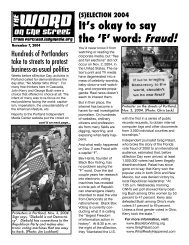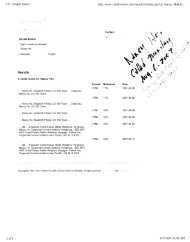Setting Fires With Electrical Timers
Setting Fires With Electrical Timers
Setting Fires With Electrical Timers
Create successful ePaper yourself
Turn your PDF publications into a flip-book with our unique Google optimized e-Paper software.
Equipment for Soldering<br />
Very little equipment is needed for soldering and all of it is inexpensive. In fact, soldering irons are so<br />
cheap that you can use a soldering iron for a single action then dispose of it without even flinching.<br />
• Soldering Iron: Get a soldering iron designed for electronic wiring. A 30-watt iron works well. Soldering<br />
irons are sold at hardware stores, auto part stores and Radio Shack.<br />
• Solder: Use rosin core solder. Do not use acid core solder – it is not meant for electrical connections. Use<br />
“fine” solder with a diameter of .03 inches or thereabouts. Although slightly thicker solder (such as .06 inch<br />
diameter) will work, .03 inch diameter solder is much easier to melt and apply.<br />
• Heat Sink: A heat sink can be helpful, especially when learning. A heat sink is a spring-activated clip that<br />
grabs onto a wire or onto a prong of a component. It absorbs the heat that would otherwise travel down the<br />
wire and burn your fingers or damage the electronic component. When using the heat sink on wire, place it<br />
on the stripped portion of wire, not on the insulation.<br />
• Soldering Stand: A soldering stand has alligator clips for holding components as you solder them. If you<br />
don’t have one, you’ll probably need an assistant to hold components for you. A human assistant will<br />
eventually get tired and maybe even grumpy. It is better to invest in a soldering stand. The simple ones cost<br />
only $5 to $15 and can be found at Radio Shack.<br />
You’ll be spending a lot of time at the work area, so make it a comfortable place to work. An extension cord for<br />
the soldering iron allows more flexibility in setting up the work area. A bright lamp makes it much easier to<br />
work with small parts.<br />
Read the Instructions Carefully<br />
The recipes in this manual were gathered from a variety of publications. They have all been tested many<br />
times. The recipes have been expanded to fill in missing steps, to add clarity and to warn about potential mistakes.<br />
This makes the instructions a lot longer but much easier to follow.<br />
Several experiments were conducted in which people who had never built a timer were asked to construct one<br />
using the recipes in this manual. These volunteers often read all the way through the instructions, then set them<br />
down, and built the timer or igniter without referring back to the instructions. The volunteers made many mistakes<br />
that could have been avoided if they had followed the instructions step by step.<br />
These recipes have been carefully crafted. You should read them with an equal amount of care. Every<br />
sentence is there for a reason. After you finish all the steps in the “Construction” section, be sure to read the other<br />
sections. The Testing, Tips and Placement sections contain critical information.<br />
14
















